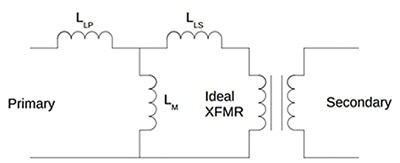Using Planar Transformers in DC-DC Converter Designs
投稿人:DigiKey
2016-09-06
In general, there is not a huge difference between implementing a planar transformer versus a comparable conventional transformer in a DC-DC converter design. However, they don’t perform as well as conventional transformers when used in a flyback topology, and since they are relatively uncommon, finding one that meets your specifications can be difficult.
One method of evaluating a planar transformer would be to try simulating it in a software package such as LTspice. To get a decent approximation of the transformer’s performance, it is necessary to use the transformer’s equivalent circuit as shown in Figure 1 below.

Figure 1: Transformer equivalent circuit.
While software simulation is valid, there’s nothing like real-world testing. The best evaluation would be to breadboard two simple DC-DC converter circuits, one with the planar transformer and one with a conventional one, enabling direct comparison of the transformer’s performance.
The evaluation circuits do not necessarily have to operate at the same input voltage, output power, etc. as your final design, but they should operate so that the transformers are within their recommended specifications. Using a manufacturer’s reference design for the converter circuit is recommended in order to minimize the factors other than the transformers that would affect the overall performance.
免责声明:各个作者和/或论坛参与者在本网站发表的观点、看法和意见不代表 DigiKey 的观点、看法和意见,也不代表 DigiKey 官方政策。








